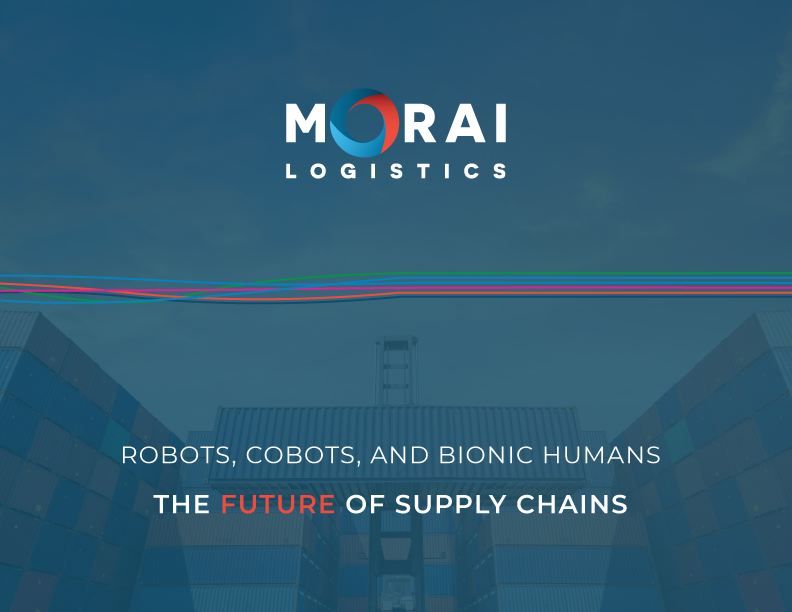Ebook: Robots, Cobots, and Bionic Workers – the Future of Supply Chains
https://morailogistics.com/morai-logistics-ebook-robots-cobots-bionic-workers-future-supply-chains/
The nature of supply chains are quickly changing with advent of robots, but that doesn’t mean human workers don’t have a place in them—here’s what the future of supply chains could look like.
Much has been made of the advent of autonomous robots and what they mean for the future of supply chains. Questions have been raised over their growing prominence and whether human workers are set to be replaced. Recently, however, with cobots and bionic workers coming into the picture a new wrinkle has been added to this new paradigm.
It appears that robots and humans are no longer in a zero-sum game but rather can be most productive together. We’ve already talked about cobots, just what they are, how they bridge the human-robot divide, and how they will help supply chains. But they are just one component of an evolving work environment in supply chains.
This ebook explains what autonomous robots, cobots, and bionic workers are, why each of them are successful, and why supply chains will be using all three going forward.
What Does Work in Supply Chains Look like in the Future?

That’s it for us this week! If you liked this blog post, why not subscribe to our blog? Interested in our 3rd party logistics services? If so, don’t hesitate to check out our services . We’re also in the twittersphere, so give us a follow to get the latest logistics and supply chain news.
Cobots: What are They and How are They Helping Supply Chains?
https://morailogistics.com/cobots-helping-supply-chains/
Cobots or collaborative robots are changing the way supply chains operate, but just what are they and what makes them valuable?
Supply chains are in a state of transformation. Technological innovations are driving supply chains forward, making them more productive and efficient. Artificial intelligence, automation, robotics, blockchain technology, and many more other advancements in technology are taking supply chains to new heights. Digital transformation is central to most of these changes.
As an article from GlobeCon Freight Systems explains,
Supply chain management is undergoing a significant transition that will change the face of shipping and logistics. Companies who aren’t starting to plan for digitization aren’t going to recognize the industry in the years to come.
In many ways these develops are pushing out more and more human workers for their digital or robotic counterparts. This paradigm shift presents an opportunity for a technology that bridges the gap between and best utilizes human expertise and digital and robotic efficiency. That’s where cobots come in.
This week’s article by Morai Logistics discusses what cobots are and the many ways in which they are useful for a supply chain.
What are Cobots?
Cobots are collaborative robots. Robots that work with or side-by-side with humans.
Or, as the IFA expounds,
Collaborative industrial robots are complex machines which work hand in hand with human beings. In a shared work process, they support and relieve the human operator.
As such, they represent a middle ground between automation and human labor. With that in mind, just what benefits are they providing supply chains?
Increased Productivity
Just as with the use of regular robots, cobots, too, help boost productivity. Cobots are more accurate and less error-prone than humans, while also able to do more physically demanding tasks. What this results is an increase in output of whatever activity they’re tasked to perform. That, in turn, frees up the human workers they’re working alongside to focus on other activities that only they can do. In this way, productivity is improved on two fronts.
Reduced Worker Injury/Strain
As a consequence of cobots being able to handle the more laborious operations in a supply chain, workers avoid straining themselves.
A Supply Chain Dive post from earlier this year expands on this topic,
Industrial physical ailments like back strain tend to escalate when shelving is too high and picking volume has dramatically increased. Robotic picking can eliminate some of this risk.
Overcoming Long Distances
The spaces in warehouses are getting larger due to the market demands placed upon them.
CBRE’s Jack Fraker touches on in his post,
E-commerce operators require up to three times more space than traditional warehouse users due to a greater diversity in products handled and the need to have them immediately accessible.
Consequently, workers have larger distances to traverse in order to fulfill their requirements. Realistically, given customer expectations, this is an impossible task for workers—they need assistance. Thus, cobots are invaluable here. In conjunction with AI, cobots can bring the right shelves to the workers.
Happier Workers
Workers in a supply chain generally don’t get much enjoyment out of repetitive and laborious activities. Therefore, cobots taking care of such activities tend to make them considerably happier. Moreover, this leads to additional benefits like limiting reductions in motivation.
An article from WiredWorkers highlights this,
The boring, monotonous work will be outsourced to the robot so that employees will do their work more ‘humanely’… In this sense, robots contribute to an attractive working environment.
Easy Use and Implementation
Cobots are simple to use and straightforward to implement. Not only that, but their implementation is fast. Many traditional robots can take hours if not days to get ready, between their softwares being programmed and installed. Whereas cobots can be up in running in as soon as an hour.